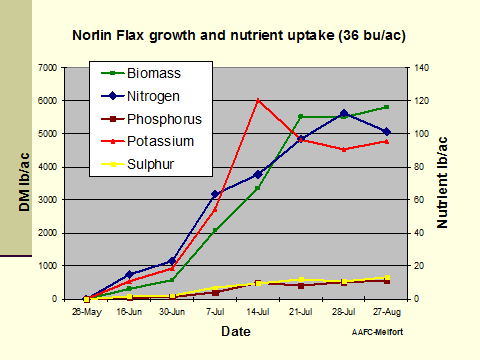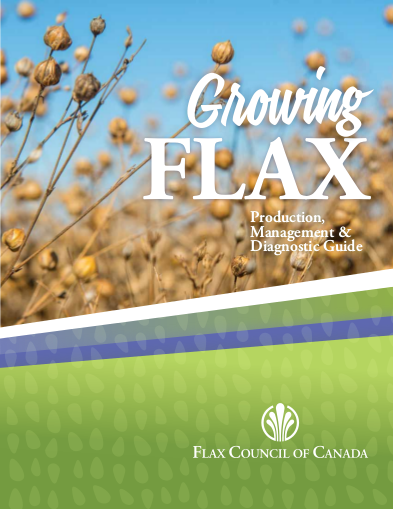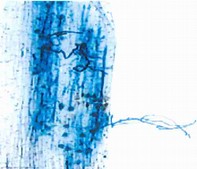Chapter 3: Fertilizer Practices
Chapter 3 – PDF version
Download the PDF version of ‘Chapter 3: Fertilizer Practices’.
Soil tests, science-based research, and experience should guide fertilizer practices. Nutrient levels in the soil vary greatly among regions, with soil types, cropping history and fertilizer use. Soil tests and provincial fertilizer nutrient fact sheets should be referred to for recommendations regarding fertilizer requirements, rates and placement.
Placement Methods
Seed-placed fertilizer
Flax is very sensitive to seed-placed fertilizer and even low rates may cause seedling injury. Some provinces recommend that a low rate of phosphate may be placed with the seed; not more than 17 kg/ha (15 lb./acre) of P2O5. Other provinces recommend that no fertilizer be placed with the seed of flax. Considerable research has now shown that placement of phosphate banded to the side of the seed row or in a mid-row placement, is an effective method to improve phosphorus nutrition for flax. Nitrogen (N) should not be placed directly with the seed. Recent work has shown that adding nitrogen to the phosphorus when placed to the side or mid-row does not change the benefits of the phosphorus placement.
Also, recent work has shown that adding the nutrients P-K-S together in a single band did not negatively influence the response to nitrogen, indicating the feasibility of applying all nutrients together in a single band to the side or mid-row for flax. For nutrient uptake by flax throughout a typical growing season see Figure 3-1.

Figure 3-1. Nutrient uptake by flax during a typical growing season. Agriculture and Agri-Food Canada-Melfort.
Estimated Nutrient Uptake by Flax in pounds per bushel
|
Total uptake lbs Nitrogen/bu 2.6 – 3.2 |
Total uptake lbs Phosphorus/bu 0.75 – 0.92 |
Total uptake lbs Potassium/bu 1.6 – 2.0 |
Total uptake lbs Sulphur/bu 0.5 – 0.6 |
|
Removal of N in the harvested flax seed lbs N/bu* 1.9 – 2.3 |
Removal of P2O5 in the harvested flax seed in lbs P2O5/bu 0.6 – 0.7 |
Removal of K2O in the harvested flax seed in lbs K2O/bu 0.5 – 0.7 |
Removal of S in the harvested flax seed in lbs S/bu 0.2 – 0.3 |
*Removal refers to the nutrients in the harvested seed portion of the crop that is removed from the field and exported off the farm.
-Estimates are calculated from the Nutrient Uptake and Removal by Field Crops. Western Canada 2001. Canadian Fertilizer Institute.
APP for the Nutrient Removal Calculator for Flax
The International Plant Nutrition Institute (IPNI) has prepared an APP Nutrient Removal Calculator (removal refers to the nutrients in the grain portion of the crop and a separate calculation is made for nutrients in flax straw) to provide producers with quick access to estimates of nutrient removal by crops.
The IPNI Nutrient Removal Calculator can be found at: http://www.ipni.net/article/IPNI-3346 or can be downloaded as an APP from the APP Store at iTunes for free.
For more accurate nutrient recommendations for crop production, conduct a soil test. Nutrient uptake charts and Nutrient Removal Calculator APPs only provide quick guidance for making last minute adjustments to nutrient plans. The nutrient charts and APPs are not intended to replace soil testing. Values presented in nutrient uptake and removal tables and calculator APPs will vary because these are only estimates.
NITROGEN
Flax responds well to nitrogen (N) fertilizer application when available soil N is low. Follow soil test recommendations for optimum yield and quality. However in the absence of a soil test, apply 45 to 110 kg/ha (40 to 98 lb./acre) of actual N; with the rate selected based on anticipated N-supplying capacity of the soil and flax yield potential. N should not be placed directly with the seed. At higher rates of N, lodging may occur, so select varieties with the best lodging resistance. Also, seeding flax earlier tends to produce shorter straw which may help reduce lodging under higher yield targets.
PHOSPHORUS
The flax plant appears to prefer high soil phosphorus (P) levels originating from P fertilization of preceding crops (soil residual P), compared to the application of a high rate of P fertilizer at seeding. Flax requires arbuscular mycorrhizal fungi (AMF) to use soil residual P efficiently (see Figure 3-2). AMF is a microorganism that creates a symbiotic relationship with plant roots, whereby plants benefit with enhanced nutrient uptake from the thread-like fungal mycelia.
Studies have shown that flax following wheat, a mycorrhizal crop, performed better than flax following canola, a non-mycorrhizal crop. However, there appeared to be no difference in mycorrhizal activity in flax in long-term zero-till fields. Studies with AMF inoculants in flax suggest the AMF are ubiquitous organisms and occur widely in prairie agricultural soils. There is good evidence to indicate that flax is dependent on AMF colonization, in part to optimize uptake of relatively immobile nutrients such as P, as well as some micronutrients. Results suggest that yield response to commercial AMF inoculants may be limited, at best. Results also suggest that the indigenous populations of AMF, made up of hundreds of AMF species, may be more than adequate to support effective and beneficial associations for flax. Follow soil test recommendations and do not exceed the safe rate of phosphate applied with the seed.
POTASSIUM AND SULPHUR
Deficiencies of potassium (K) and sulphur (S) can limit production of all crops; but they are soil‐specific. Soil testing is required to determine the K and S status of your soils. Deficiencies of K are often associated with coarser textured (sandy) soils and deficiencies of S may occur in low organic matter soils. On irrigated land, there is normally enough sulphur in most irrigation waters to meet crop requirements. Approximately 34 kg/ha (30 lb./acre) of sulphur is added to the soil with each 30 cm (12 inches) of irrigation water.
IRON AND ZINC
Flax may be sensitive to soil deficiencies of iron (Fe) and zinc (Zn). Under wet soil conditions, temporary iron deficiency can cause chlorosis (yellowing of the leaves) in irregular patterns in the field. However, field tests have seldom shown any flax yield increase attributable to application of micronutrients. If a micronutrient deficiency is suspected, confirm with a soil test. Strip tests of micronutrients can be carried out to confirm if flax is responsive.





